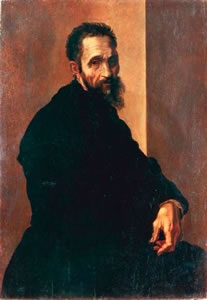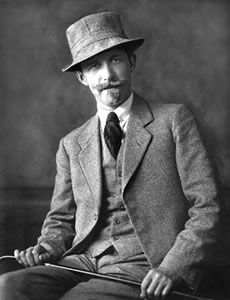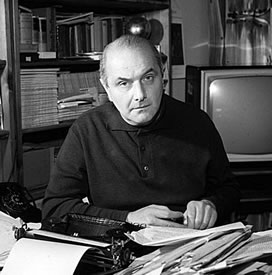De Noorse schrijver Jan Kjærstad werd geboren op 6 maart 1953 in Oslo. Zie ook mijn blog van 6 maart 2007 en ook mijn blog van 6 maart 2009.
Uit: The Discoverer (Vertaald door Barbara Haveland)
„Behold this man. Behold this man, as he feels three tugs on the rope and slowly, after smiling uncertainly, proceeds to traverse, to edge out onto those dauntingly airy galleries. Behold this man as he inches across the rock face; see how with the caution of the novice he feels his way forward using all of his limbs, his whole body in fact, before shifting his weight from one foot to the other. I can sense how frightened, how truly terrified he is, and yet how full of the determination to do this, to see it through, make it to the top. And then, suddenly, as if something has ground to a halt, he freezes. He shuts his eyes. He looks as though he is listening to the wind, while at the same time concentrating hard, trying to place the scent emanating from the rock against which he is pressed. The bright sunlight glitters off the cliff face, sparkles in the runnels of meltwater. As far as I can see he is holding his breath. I have known it all along. This is the moment of truth. On a ledge, with a drop of hundreds of meters into the abyss only a step away. Here you live, or you die.
“This is a second I shall remember.”
Then he does the one thing I have begged him not to do. He half turns, while apparently hanging on tight with both hands. He looks out. Looks down. As if intent on defying something. Proving something. For a moment he seems to be completely dazzled by the Slingsby glacier far below. Or no, not dazzled, but stunned, panic-stricken. Psyched out, as they say. I refuse to believe it. That this man could be afraid of anything, a man who brought thousands of cars to a halt on Oslo’s Town Hall Square and who, by his mere presence, drew a cyclone to himself; a man who has been with three fair maids at once and who would not hesitate to dive to a depth of fifteen meters without an oxygen tank.“

Jan Kjærstad (Oslo, 6 maard 1953)
De Italiaanse beeldhouwer, schilder, architect en dichter Michelangelo werd geboren op 6 maart 1475 in Caprese. Zie ook mijn blog van 6 maart 2009.
Celestial Love
No mortal thing enthralled these longing eyes
When perfect peace in thy fair face I found;
But far within, where all is holy ground,
My soul felt Love, her comrade of the skies:
For she was born with God in Paradise;
Nor all the shows of beauty shed around
This fair false world her wings to earth have bound:
Unto the Love of Loves aloft she flies.
Nay, things that suffer death, quench not the fire
Of deathless spirits; nor eternity
Serves sordid Time, that withers all things rare.
Not love but lawless impulse is desire:
That slays the soul; our love makes still more fair
Our friends on earth, fairer in death on high.
Vertaald door John Addington Symonds

Michelangelo (6 maart 1475 – 18 februari 1564)
Portret door Jacopino del Conte, na 1535
De Duitse schrijfster Elisabeth Castonier werd geboren op 6 maart 1894 in Dresden. Haar eerste roman Frau, Knecht, Magd verscheen in het Berliner Tageblatt. Tijdens het Derde Rijk ging zij in ballingschap, eerst naar Wenen, later naar Italië en tenslotte naar Engeland. Zij werkte voor de BBC en werd correspondente voor bladen als de News Chronicle, de New Statesman en emigrantenbladen als de Pariser Tageszeitung en het Wiener Tageblatt. Vanaf 1944 werkte zij als landbouwster. In 1955 kon zij om gezondheidsredenen dit werk niet langer doen. Zij trok naar een Cottage in Wiltshire en begon opnieuw te schrijven, vaak goedverkopende, vrolijke verhalen over het leven in Engeland.
Uit: Stürmisch bis heiter. Memoiren einer Außenseiterin
„Ich ging mit Ines zum Opernplatz, denn dergleichen sieht man nur einmal im Leben – und außerdem war es gut, Zeuge gewesen zu sein.
Menschenmassen strömten die Linden entlang, Musikkapellen spielten, es herrschte Feiertagsstimmung. Fackelzüge marschierten auf, Studenten umstanden den Scheiterhaufen, warfen ihre Fackeln in die Flammen, hochbeladene Lastwagen brachten das Brennmaterial, die deutsche Literatur. Zuerst kamen die Prominenten, später alles, was aus Verlagen und Buchhandlungen an verbotenen Schriftstellern abgeholt worden war.
Ines bemerkte: »Dies ist natürlich der größte Scheiterhaufen aller Zeiten, weil er vom größten Führer aller Zeiten und dem größten Schreier aller Zeiten befohlen worden ist.«
(…)
Nachdenklich stimmen die Einzelschicksale, die nur geschichtliche Randnotizen (wenn überhaupt) blieben, aber Existenzen und Familien zerstörten.
Beim Rundfunk arbeitete ich längst nicht mehr. Dort waren alle, die ich gekannt hatte, entlassen worden oder geflohen. Zu ihnen gehörte ein Mann, der sich später mit seiner Frau, seinem Bruder und seiner Schwägerin vor Capri mit Steinen beschwert ertränkte. Sie hinterließen einen Brief, in dem sie mitteilten, daß kein Land ihnen Einreisebewilligung erteilt hätte und ihre Aufenthaltsbewilligung in Italien befristet wäre. Sie hofften, daß sie in dem Land, in das sie sich jetzt flüchteten, freundlich aufgenommen würden.”

Elisabeth Castonier (6 maart 1894 – 24 september 1975)
De Noorse schrijver Johan Bojer werd geboren op 6 maart 1872 in Orkdal. Hij was een buitenechtelijk kind van een dienstmeisje en een handelsreiziger. Hij groeide op als pleegking van de familie Fætten in Rissa. Hij werkte o.a. als visser, boer, vertegenwoordiger en boekhouder. In 1893 publiceerde Bojer zijn eerste literaire werk Unge tanker, onder het pseudoniem Johan K. Hansson. Een kleine erfenis van zijn vader stelde hem in 1895 in staat naar Parijs te gaan, waar hij tot 1915 bleef en kennis maakte met de schrijvers Knut Hamsun en August Strindberg. Ook Victor Hugo had invloed op zijn werk. Zijn belangrijkste werk is wellicht Den siste viking (De laatste Viking) uit 1921.
Uit: The Great Hunger (Vertaald door W. J. Alexander Worster en C. Archer)
“For sheer havoc, there is no gale like a good northwester, when it roarsin, through the long winter evenings, driving the spindrift before itbetween the rocky walls of the fjord. It churns the water to a frothof
rushing wave crests, while the boats along the beach are flung insomersaults up to the doors of the grey fisher huts, and solid old barngangways are lifted and sent flying like unwieldy birds over the fields.
“Mercy on us!” cry the maids, for it is milking-time, and they haveto fight their way on hands and knees across the yard to the cowshed, dragging a lantern that WILL go out and a milk-pail that WON’T be held. And “Lord preserve us!” mutter the old wives seated round the stove within doors–and their thoughts are far away in the north with the Lofoten fishermen, out at sea, maybe, this very night.
But on a calm spring day, the fjord just steals in smooth and shining by ness and bay. And at low water there is a whole wonderland of strange little islands, sand-banks, and weed-fringed rocks left high and dry, with clear pools between, where bare-legged urchins splash about, and tiny flat-fish as big as a halfpenny dart away to every side. The air is filled with a smell of salt sea-water and warm, wet beach-waste, and the sea-pie, see-sawing about on a big stone in the water, lifts his red beak cheerily sunwards and pipes: “Kluip, kluip! the spring has come!”
On just such a day, two boys of fourteen or thereabouts came hurrying out from one of the fishermen’s huts down towards the beach. Boys are never so busy as when they are up to some piece of mischief, and evidently the pair had business of this sort in hand. Peer Troen, fair-haired and sallow-faced, was pushing a wheelbarrow; his companion, Martin Bruvold, a dark youth with freckles, carried a tub. And both talked mysteriously in whispers, casting anxious glances out over the water.”

Johan Bojer (6 maart 1872 – 3 juli 1959)
De Poolse dichter en aforist Stanisław Jerzy Lec werd geboren op 6 maart 1909 in Lemberg. Zie ook mijn blog van 6 maart 2007 en ook mijn blog van 6 maart 2009.
Uit: Die Tinte ist ein Zündstoff (Biografie door Marta Kijowska)
»Fasse dich kurz. Die Welt ist mit Worten übervölkert«, lautet einer von Lec’ meistzitierten Aphorismen. Was er von anderen verlangte, galt auch für ihn selbst. So schrieb oder besser kritzelte
er mit zitternder Hand im Frühjahr 1966, wenige Wochen vor seinem Tode, seine Letzte Autobiographie. Sie war wie die meisten seiner literarischen und satirischen Werke: kurz, prägnant
und voller Fragen.
War ich denn wirklich am 6. März 1909, wie es aus meinem Lemberger Geburtsschein hervorgeht, geboren? Oder vielmehr erst im Jahre 1933, als ich nach der Wiener und der Lemberger Schule und der Universität die Stätte der Rechtswissenschaft verließ, um meine erste Bekanntschaft mit dem Unrecht zu machen? Oder vielleicht wurde ich erst existent, als im selben Jahr mein Lyrikbändchen Farben aus der Druckmaschine herausfiel? Oder vielleicht erst im Jahre 1935 mit dem Erscheinen der Satirensammlung Zoo? Nun, später kam ich mehrmals auf die Welt, lyrisch und satirisch – mit jedem
Buch, mit jedem Gedicht, ja mit dem kleinsten Epigramm.
Womö
glich wurde ich aber erst im Krieg geboren? Im Konzentrationslager? Oder erst nach der Flucht vor der Hinrichtung im Jahre 1943? Oder als ich die Wälder der Partisanen im Jahre 1944 verließ? Wie viele Gelegenheiten auch danach, geboren zu werden!
Laut Geburtsschein wurde Stanisław Jerzy Lec also am 6. März 1909 in Lemberg geboren. Sein Vater, Baron Benno de Tusch-Letz, war – entgegen der Familientradition, nach der die männlichen Nachkommen den Arztberuf wählten – Bankier und Großgrundbesitzer. Er besaß Güter in Podolien und in der Bukowina und auch zwei Wohnsitze: in Lemberg und in Wien, wo seine Vorfahren in den Adelsstand erhoben worden waren.“

Stanisław Jerzy Lec (6 maart 1909 – 7 mei 1966)
De Zweedese schrijfster Victoria Maria Benedictsson werd geboren op 6 maart 1850 in Schonen. Zie ook mijn blog van 6 maart 2007 en ook mijn blog van 6 maart 2009.
Uit: Money (Vertaald door Verne Moberg)
„It was an uncommonly beautiful autumn day, and Axel Möller had put up the doors to the street to bring air and light into the dark shop. On a sugar barrel in its farthest corner he sat down with his back up against the wall and his violin beneath his chin. He was fantasizing.
There was a strange contrast between the inspired facial expression and the wretched potpourri that he was rendering. A painter who had only seen him would have been delighted; a musician who had heard would have been driven to despair. One could hear nothing more miserable than this helpless groping for something he never could reach; the striking up of well-known melodies that were not allowed to emerge as, muddling through them, he tried to make believe he was composing; then lastly these random runs, constituting the total outcome of his concert appearances. But there was no
doubt that he believed himself to be producing something beautiful, and that he drew pleasure from this.
There was a darkening in the doorway. He looked up and could see Selma. Her contours appeared sharp against the sunny background; she was dressed in a close-fitting dark-blue dress that made her look even slimmer.
“I would like to hear you play but don’t dare on your mother’s account,” she said laughing as she grabbed hold onto each door post and let her body balance forward as far as her arms reached.
His face shone with joy when he saw her, but before he could answer she was gone.
Even when she had gone he thought he heard a subdued laugh and saw a white row of teeth appear over there in the shadow. He laid the violin on the counter and thought for a moment. It was probable that she turned off at the gate and was walking home along the railway embankment. And in that case. . . It was a blessing that the overgrown current bushes were standing in the way of Mother’s window!“

Victoria Benedictsson (6 maart 1850 – 21 juni 1888)
De Franse schrijver Savinien Cyrano de Bergerac werd geboren op 6 maart 1619 in Parijs. Zie ook mijn blog van 6 maart 2007 en ook mijn blog van 6 maart 2009.
Uit: Voyage dans la lune
“… J’avais attaché autour de moi quantité de fioles pleines de rosée, sur lesquelles le soleil dardait ses rayons si violemment, que la chaleur qui les attirait, comme elle fait les plus grosses nuées, m’éleva si haut, qu’enfin je me trouvai au-dessus de la moyenne région. Mais comme cette attraction me faisait monter avec trop de rapidité, et qu’au lieu de m’approcher de la lune comme je le prétendais, elle me paraissait plus éloignée qu’à mon partement, je cassai plusieurs de mes fioles, jusqu’à ce que je sentis que ma pesanteur surmontait l’attraction, et que
je redescendaisvers la terre.”
“… J’avais fait une machine que je m’imaginais capable de m’élever autant que je voudrais en sorte que de tout ce que j’y croyais nécessaire n’y manquant, je m’assis dedans et me précipitai en l’air du haut d’une roche. Mais parce que je n’avais pas bien pris mes mesures, je culbutai rapidement vers la vallée.”
“… quand on eut découvert l’invention du ressort, quelques uns dirent qu’il fallait y attacher quantité de fusées volantes… à peine y eus-je mis les deux pieds que me voilà enlevé dans la nue…”

Cyrano de Bergerac (6 maart 1619 – 28 juli 1655)
Zie voor onderstaande schrijver ook mijn blog van 6 maart 2009.
De Italiaanse dichter Luigi Alamanni werd geboren op 6 maart 1495 in Florence.
